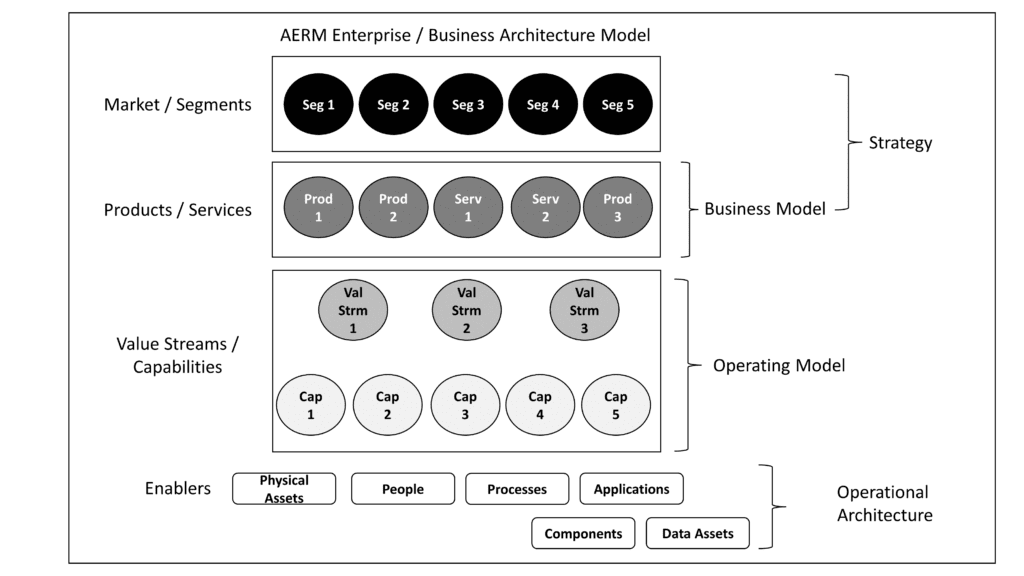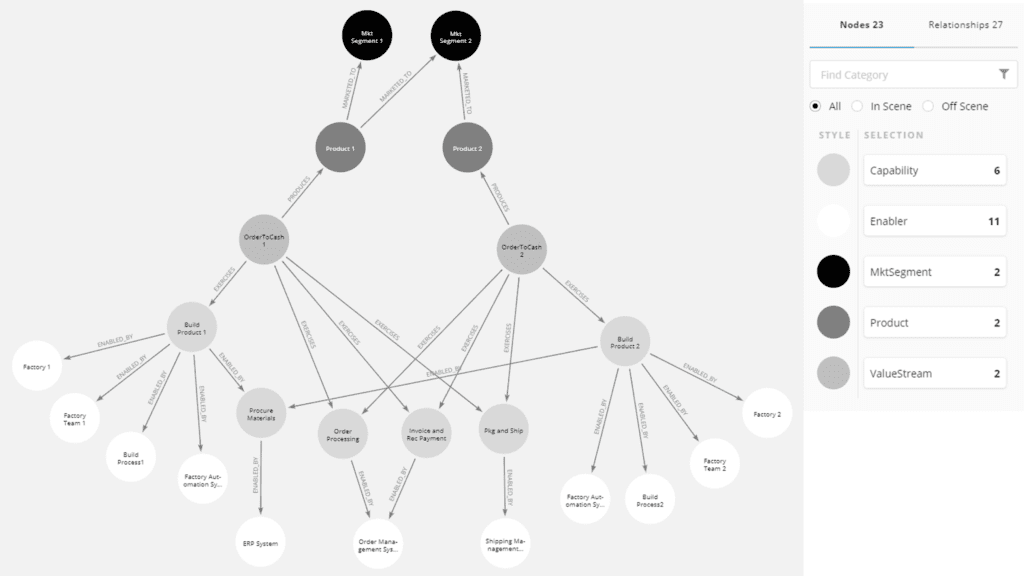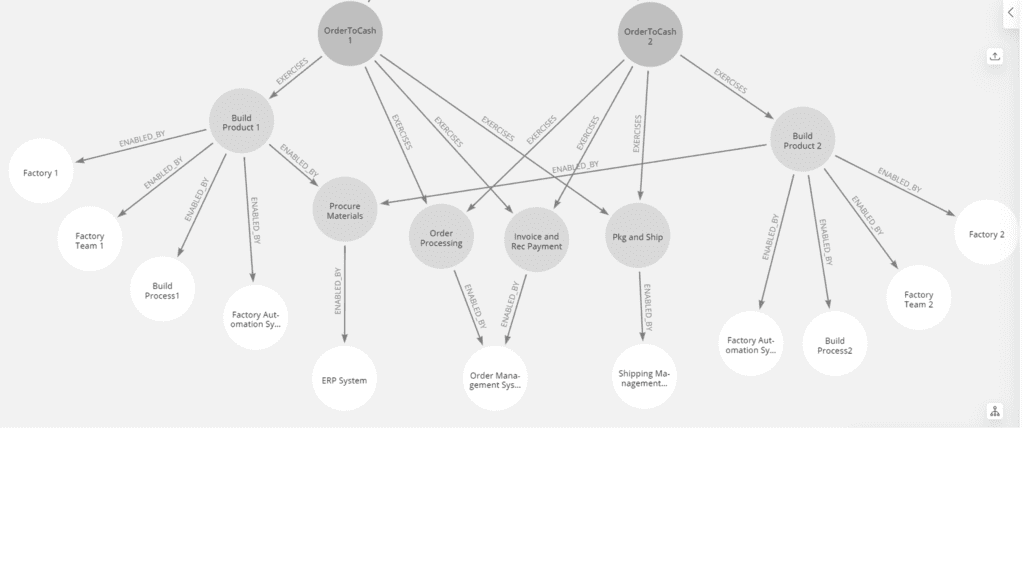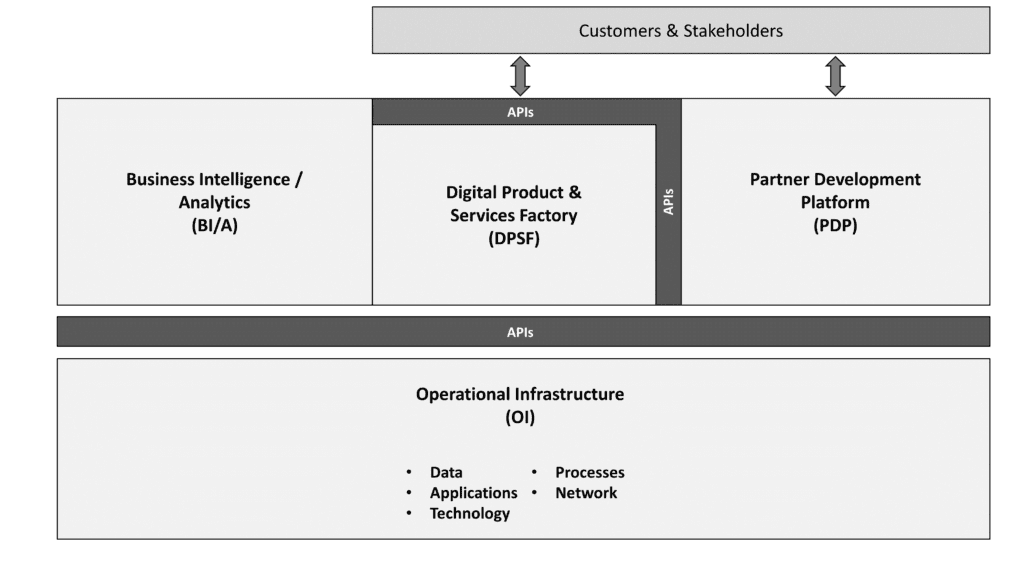
In Part I of this series, we discussed the VUCA environment in which business are operating and the impact this has had and will continue to have on how businesses are run, discussed the need for business agility and introduced the EA model that Agile ERM employs. In this article, we will look at three models that help to understand your company and inform decisions you will have to make about how to transform it to achieve sustainability.
Three Models of Your Company
A Logical model of your company consists of four layers, each of which addresses a unique set of concerns: the Business Strategy, the Business Model, the Operating Model and the Operational Architecture. Understanding how elements of these layers interact and identifying where dependencies exist is crucial to your strategic and operational decision-making.
The Enterprise Architecture model (the EA Model,) a seminal foundational component of Agile ERM, is an anatomical model based on a palette of eleven entity types: Markets/Segments, Products/Services, Value Streams, Capabilities, Enablers, Assets (can be Intellectual or Physical,) People, Processes, Applications (which consist of Components and Data Assets.)
Elements of the EA model map almost one to one to the layers of the Logical model. Graphically, the relationships appear in the diagram, below, with layers of the EA model on the left and of the Logical model on the right:

The relationship among these layers and elements is summarized in this table:
| Logical Model Layer | Relevant Concerns | EA/BA Model Elements |
| Business Strategy | To whom do you expect to be selling and what is the value proposition that you will offer? Who are the major competitors that you will have to account for and what is their value proposition? | Market Segments, Product and Service characteristics |
| Business Model | What is your Value Proposition? What specifically will you offer and to whom will it be targeted? | Products and Services targeted to specific Market Segments |
| Operating Model | How will you structure your company to produce and deliver the value that you will offer? | Value Streams, Capabilities |
| Operational Architecture | How will you structure and equip yourself to create the value? | Capabilities, Enablers |
An important aspect of the EA model is its representation of the relationships and dependencies between your value propositions—the products and services you sell—and the elements of your company that allow you to create and deliver them. A useful representation of the EA model is a graph database, in which relationships can be traced hierarchically down from Products to Enablers and among entities that may be shared. Below, is an example of an EA Model represented as a Neo4j labeled property graph:

The diagram, below, shows detail of Capabilities and Enablers that are shared between the two products, for instance, the Capabilities Procure Materials, Order Processing, Pkg and Ship and Invoice and Rec Payment and the Enablers ERP System, Order Management System and Shipping Management System.

The relevance of this to you is that it serves as a reference to allow you to trace dependencies for which you must account as you contemplate transforming your company. (N.B., it can only serve this purpose properly if you are maintaining its currency properly.)
In other articles and in my book, I’ve made the case that you need to adopt the architecture of a Digital Company. A company with a Digital Business Architecture designed to exploit digital technologies has an Operating Model and Operational Architecture consisting of six pillars: the Operational Infrastructure, API Management, the Digital Products and Services Factory, the Partner Development Platform, a set of Business Intelligence and Analytics capabilities and a Distributed Governance Model.
This Digital Business Architecture is shown in the diagram, below:

What are these pillars and how are they implemented? They are composites of multiple EA entities—most of them, Capabilities or Enablers. For instance, the Digital Products and Services Factory (DPSF) embodies Capabilities composed of integrated product management and technology teams (Enablers,) supported by software development tools (Enablers) and processes (also Enablers) intended to accelerate iterative delivery of Products and Services to the company’s Markets. In aggregate, it is the Capability to develop, implement and evolve digital products and services at speed, a very important one.
The Distributed Governance Model is an Enabler, also an important one. It is a set of processes (Enablers) and organizational entities (Enablers) that empowers your company to delegate authority to make product and business decisions to people closest to where they need to be made, while retaining control over issues that are important to your enterprise, such as regulatory compliance. It is intended to facilitate accelerated decision-making by eliminating layers of review and approval where they are not necessary.
These pillars can be mapped onto the layers of the EA model, though some appear in more than one layer:
| Layer | Digital Business Architecture Model Elements |
| Strategy | Business Intelligence and Analytics |
| Business Model | Digital Products and Services Factory, Business Intelligence and Analytics |
| Operating Model | Digital Products and Services Factory, Partner Development Platform, Business Intelligence and Analytics, Distributed Governance Model |
| Operational Architecture | Operational Infrastructure, API Integration and Management |
Reconciling the Models
So, how do we reconcile these models? They appear not to be properly related, and, in fact, they aren’t. Elements of some of the pillars appear in multiple layers of the EA model and various elements of the EA model are shared among hierarchies supporting multiple, potentially disparate, Markets, Products and Services.
Completeness is an important consideration—if you are developing a new product at the same time as you are building the plant where it will be produced, you cannot attain the strategic objective of releasing the product until both have reached a minimum level of completion. Similarly, you cannot realize the benefit of accelerated product evolution fully until you have implemented all the elements required by the Digital Products and Services Factory (the DPSF.) Defining the DPSF as the sum of its required Capabilities and Enablers ensures that you can plan for a pillar that will efficiently and effectively deliver the entire set of Capabilities and services envisioned for it. However, you can certainly realize some of the benefits by implementing a minimum viable set of its Capabilities and Enablers in the short term.
So, you can’t wait around for everything to be completed before you begin to make the changes that will make your company sustainable. When you look at it, doing all the work required to implement a pillar may well appear to burden efforts to get Products and Services to market with unnecessary overhead. That may be the case in the short term, but taking the longer view is required. Presumably, the Capabilities you are building will enable you to accelerate the development and evolution of many products and services going forward.
In the next article, I will focus on the importance of these models for informing your Digital Transformation.
